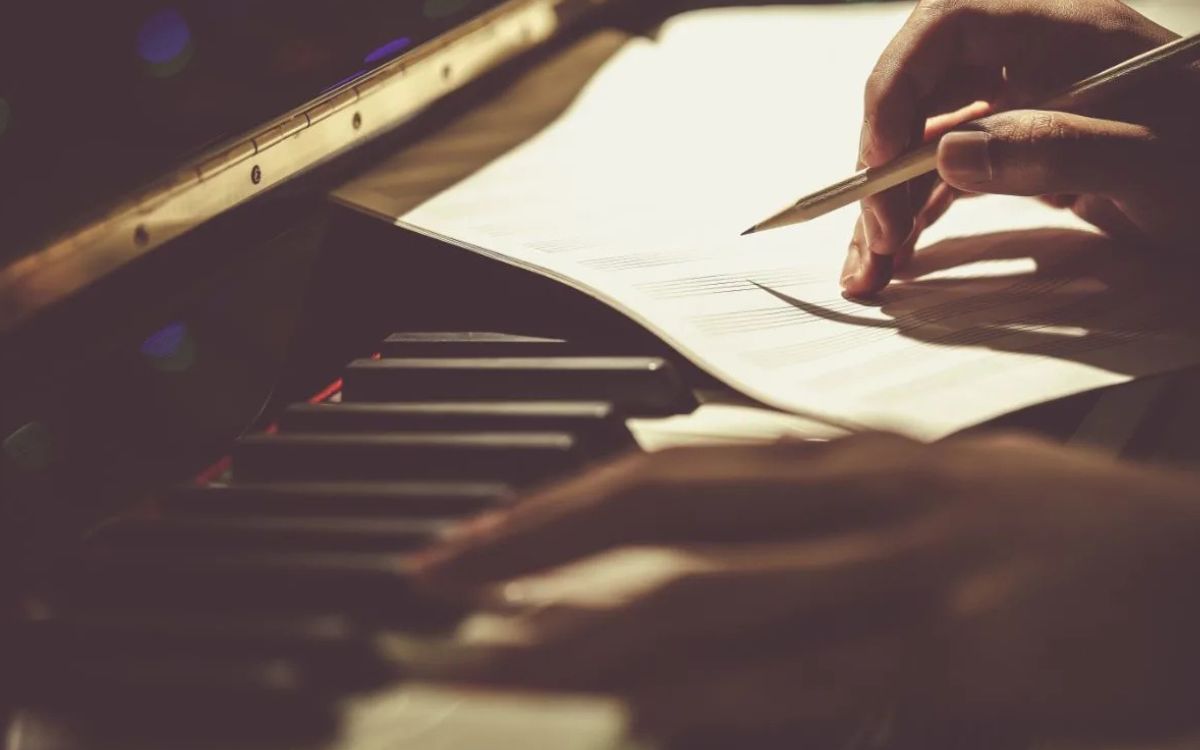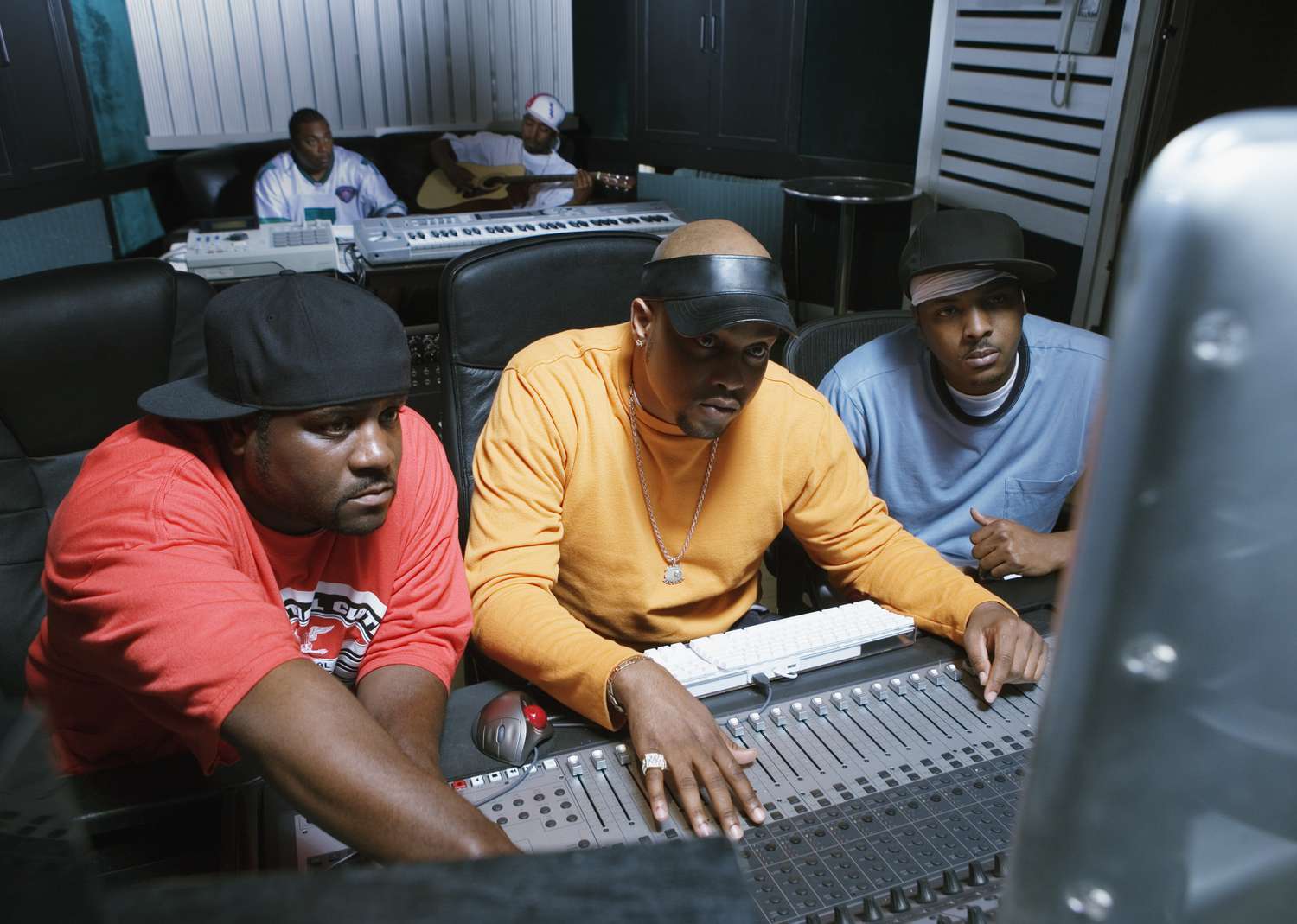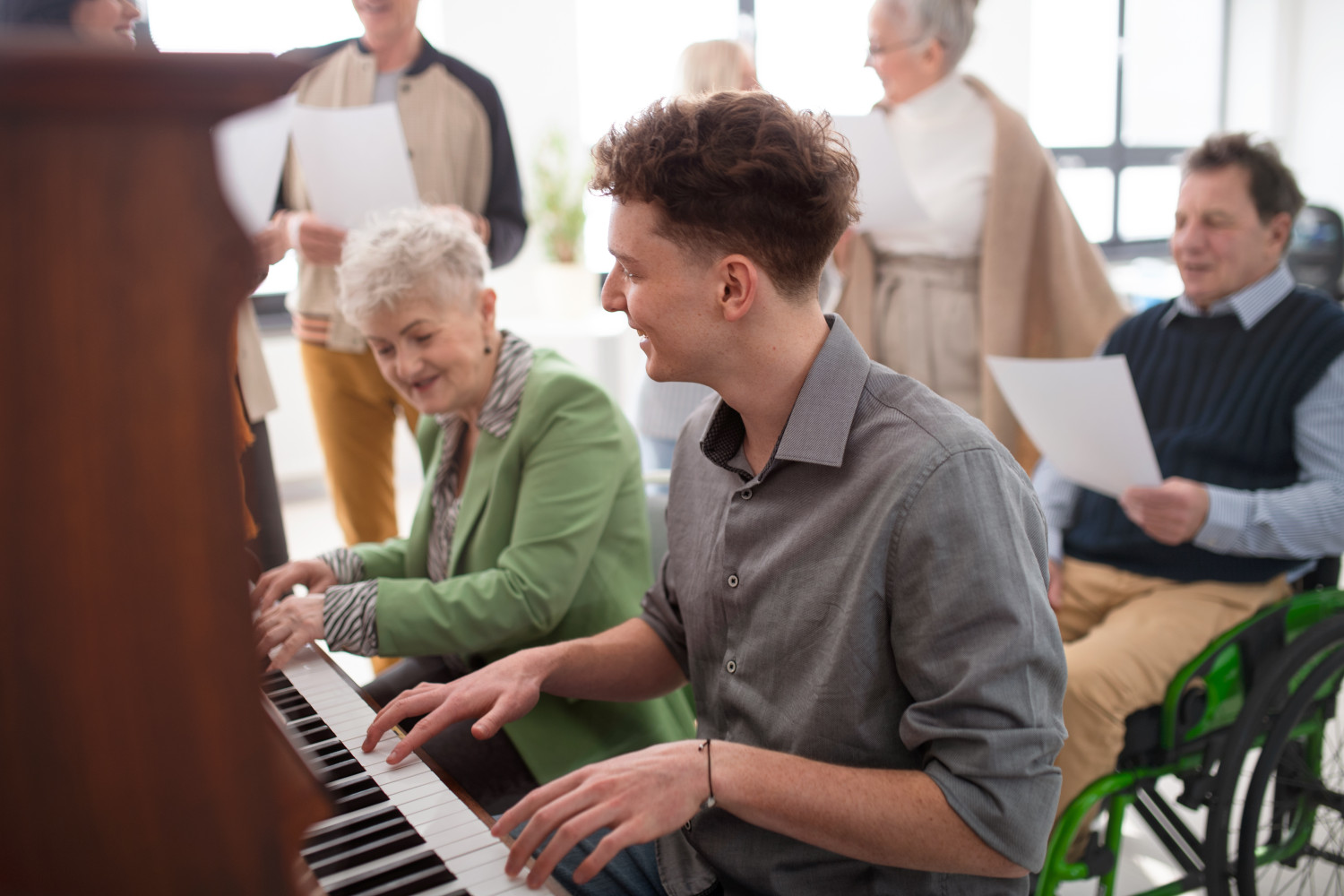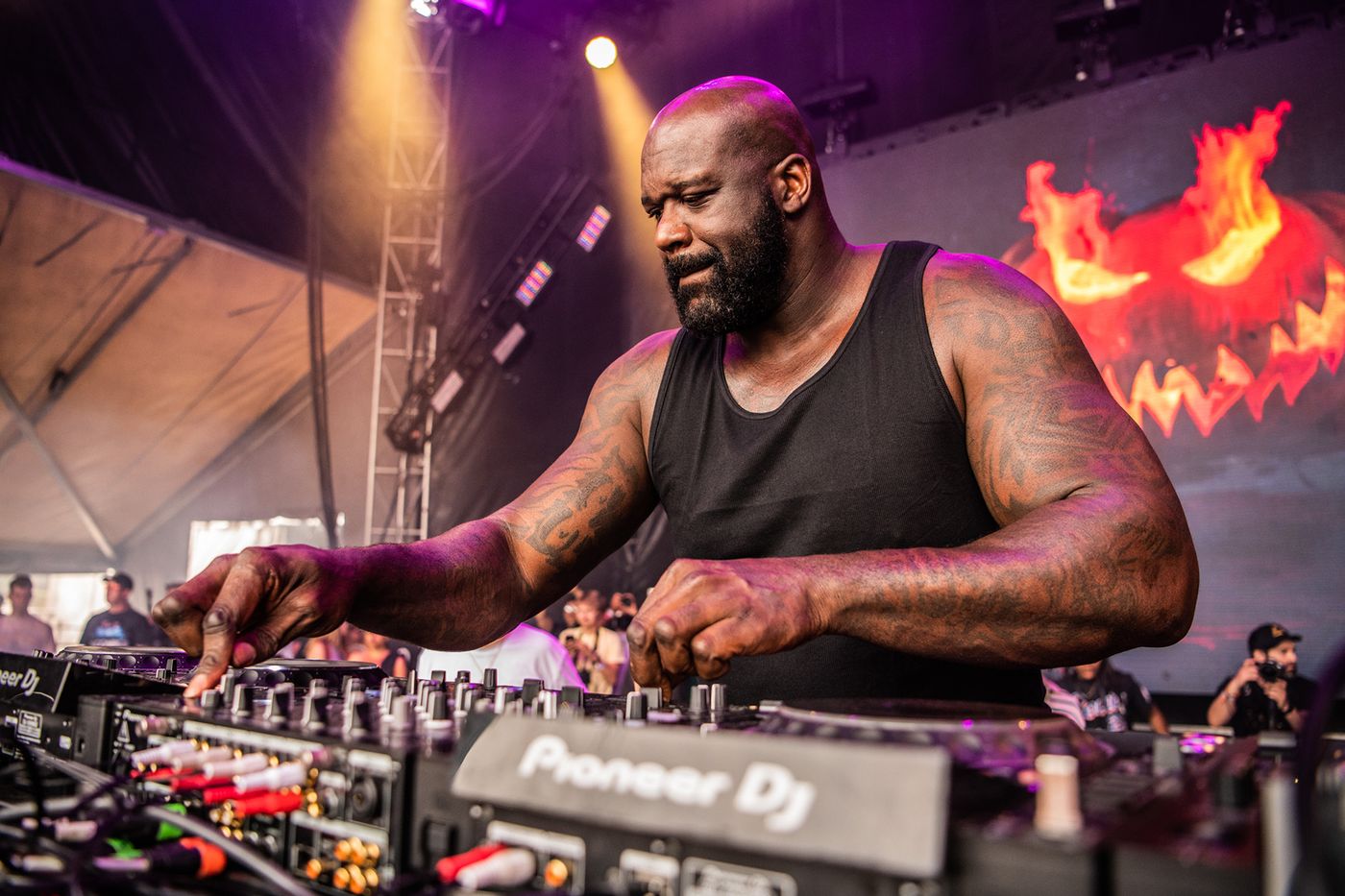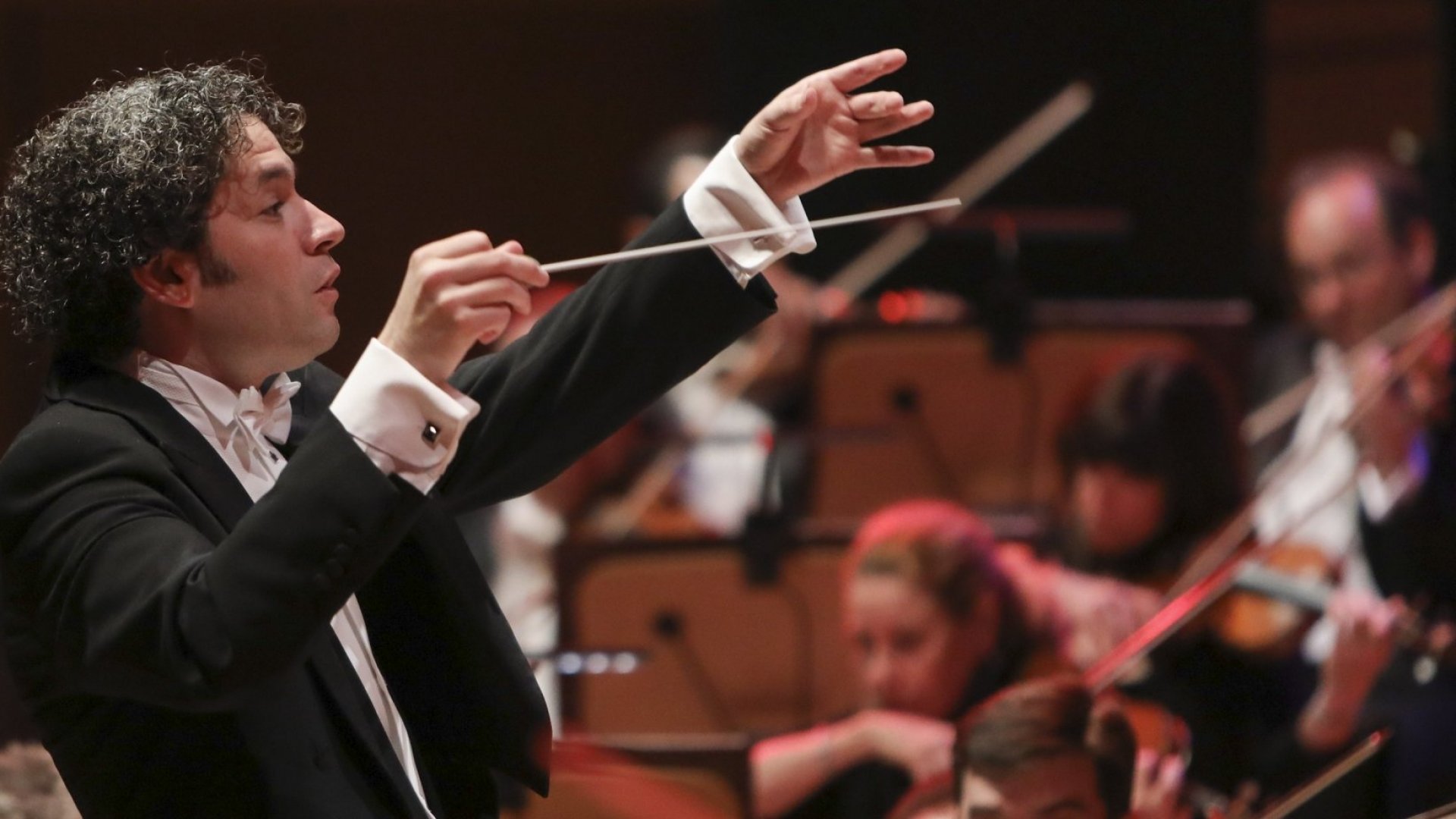Home>Production & Technology>Composer>What Does A Composer Do In Music


Composer
What Does A Composer Do In Music
Modified: January 22, 2024
Discover the role of a composer in music, from creating original compositions to collaborating with musicians and orchestrating beautiful melodies. Find out what it takes to be a composer and unlock your creative potential.
(Many of the links in this article redirect to a specific reviewed product. Your purchase of these products through affiliate links helps to generate commission for AudioLover.com, at no extra cost. Learn more)
Table of Contents
- Introduction
- Definition of a Composer
- Roles and Responsibilities of a Composer
- Writing and Composing Music
- Collaborating with Musicians and Performers
- Working with Directors and Producers
- Composing for Different Musical Genres
- Incorporating Techniques and Styles
- Challenges and Rewards of Being a Composer
- Conclusion
Introduction
Music has the power to evoke emotion, stir the soul, and transport us to another world. Behind every beautiful composition lies a talented and skilled composer who crafts the melodies, harmonies, and rhythms that resonate with millions of listeners. But what exactly does a composer do? In this article, we will delve into the world of composers, exploring their roles, responsibilities, and the artistry behind their craft.
A composer, in simplest terms, is a musician who creates original music. They are the masterminds behind the symphonies, film scores, opera arias, and catchy pop tunes that captivate our ears. They possess a profound understanding of musical theory, composition techniques, and instrumentation, allowing them to weave together notes and sounds into a cohesive and meaningful piece.
Composers play a vital role in the music industry, influencing the way we experience and interpret music. Through their compositions, they channel their emotions, stories, and messages, leaving an indelible mark on both the performers and the listeners. Their work can transcend language barriers, cultural differences, and time, resonating with people from various backgrounds and generations.
A composer’s journey begins with a blank sheet of manuscript paper or a digital audio workstation. It is through their creative process that they breathe life into their musical ideas. This involves experimenting with melodies, harmonies, rhythms, and instrumentation to craft a unique and compelling piece. They carefully consider the mood, tone, and message they want to convey, making deliberate choices to evoke specific emotions in the listener.
While the image of a solitary composer pouring over musical notation may come to mind, the reality is often different. Collaboration is a crucial aspect of a composer’s work. They frequently collaborate with musicians and performers to bring their compositions to life. This collaboration allows for interpretation, adaptation, and refinement, resulting in a dynamic and powerful musical performance.
Composers also find themselves collaborating with directors and producers in film, television, and theater. They work closely with these individuals to create compositions that amplify the mood, atmosphere, and narrative of a project. This collaborative synergy between composer, director, and producer ensures that the music seamlessly integrates with the visual and dramatic elements, enriching the overall experience for the audience.
Definition of a Composer
A composer is a musical artist who possesses the unique ability to create, arrange, and write original musical compositions. They are skilled in the art of translating their inner musical vision into tangible notes and sounds. With a deep understanding of musical theory, composition techniques, and instrumentation, composers have the power to shape and create music that resonates with the listener on an emotional and intellectual level.
Composers are not limited to a single musical genre or style. They can be found in classical music, film scoring, popular music, jazz, electronic music, and many other genres. Their compositions can range from intricate symphonies performed by large orchestras to catchy pop songs played on the radio. Regardless of the context or genre, composers leave their unique mark on every piece they create.
One of the defining characteristics of a composer is their ability to generate original musical ideas. They are not only proficient in playing an instrument or singing, but they also possess the gift of musical imagination. Composers can hear melodies in their minds, envision harmonies, and arrange intricate musical structures. They use their creativity to express their emotions, tell stories, and evoke specific moods through the language of music.
It is important to note that being a composer is not limited to writing music for performance. Composers also work in other mediums, such as film, television, and multimedia projects. They create soundtracks that enhance the visual and dramatic elements of a production, effectively becoming storytellers with their music. In these cases, composers collaborate closely with directors, producers, and sound designers to ensure that the music aligns with the creative vision of the project.
Composers often begin their creative process with a blank canvas. They may start by brainstorming ideas, experimenting with different melodies, or improvising on their instrument. Once they have a core musical idea or concept, they refine and develop it, carefully considering the structure, dynamics, instrumentation, and overall sonic palette of the piece. They use musical notation or digital audio workstations to notate and record their compositions, allowing them to communicate their musical vision to performers or for future reference.
Ultimately, composers are artists who use music as their medium of expression. They have the ability to inspire, influence, and captivate audiences through their compositions. Their role in the music industry is essential, as they contribute to the vast tapestry of musical creations that enrich our lives.
Roles and Responsibilities of a Composer
A composer’s role extends far beyond simply creating beautiful melodies and harmonies. They have a variety of responsibilities that contribute to the success of their compositions and the overall artistic impact. Let’s explore some of the key roles and responsibilities of a composer:
1. Creative Vision: The composer is the visionary behind the music. They conceive and develop the creative concept, setting the tone and mood of the composition. They have the ability to translate emotions, stories, and ideas into a musical language that resonates with the listener.
2. Composition and Arrangement: The primary responsibility of a composer is to compose and arrange musical pieces. They develop the structure, form, and thematic elements of a composition, considering the balance of melodies, harmonies, rhythms, and textures to create a cohesive and engaging musical experience.
3. Musical Interpretation: Composers bring their compositions to life through interpretation. They determine the appropriate dynamics, articulations, tempo, and phrasing to convey their intended musical expression. This interpretation may be communicated through musical notation or through direct collaboration with performers.
4. Collaboration: Composers frequently collaborate with other musicians, performers, orchestras, and ensembles to bring their compositions to fruition. They work closely with these individuals to ensure that their musical ideas are realized, incorporating their expertise and input into the final performance.
5. Instrumentation and Orchestration: Composers possess a deep knowledge of different instruments and their capabilities. They are responsible for selecting and arranging the instrumentation for their compositions, ensuring that each instrument contributes to the overall sonic palette and enhances the desired emotional impact.
6. Technical Aptitude: Composers must have a strong technical understanding of music theory, harmony, counterpoint, and composition techniques. This allows them to craft intricate musical structures, utilize compositional devices, and experiment with innovative musical ideas.
7. Adaptation and Revision: Composers are open to feedback and are willing to make revisions and adaptations to their compositions. They work closely with performers, directors, and producers to refine and adjust the music according to the specific requirements of the performance or project.
8. Research and Inspiration: Composers are often engaged in continuous research and exploration of different musical styles, genres, and historical periods. They draw inspiration from various sources, integrating elements from different musical traditions and cultures to create unique and eclectic compositions.
9. Time Management and Deadlines: Composers must be adept at managing their time effectively to meet deadlines and deliver their work promptly. They understand the importance of punctuality and are skilled at juggling multiple projects simultaneously while maintaining the highest quality standards.
10. Lifelong Learning: Composers are committed to their craft and never stop learning. They constantly strive to expand their musical knowledge, refine their skills, and explore new approaches to composition. They attend workshops, study scores, and engage in professional development opportunities to stay current in the ever-evolving world of music.
Overall, a composer wears many hats, combining artistic vision, technical expertise, and collaborative skills to create music that connects with audiences and stands the test of time.
Writing and Composing Music
At the heart of a composer’s work is the process of writing and composing music. It is through this creative journey that they give life to their ideas, emotions, and stories. Let’s explore the intricacies of writing and composing music:
1. Developing Musical Ideas: The process begins with a spark of inspiration—a melody, a chord progression, or a rhythmic pattern. Composers often draw inspiration from their surroundings, personal experiences, nature, or other forms of art. They develop these initial ideas, exploring different variations and possibilities to shape them into a complete musical piece.
2. Musical Structure: Composers consider the structure of their compositions, determining the order and arrangement of sections, such as verses, choruses, and bridges. They create a coherent flow that guides the listener through different musical moments, using techniques like repetition, contrast, and development to maintain interest and build tension and release.
3. Harmony and Melody: Composers carefully craft harmonies and melodies to evoke specific emotions and convey their musical message. They experiment with chord progressions, modulations, and melodic intervals to create expressive and memorable musical phrases. They strike a delicate balance between familiarity and surprise, engaging the listener’s ear and creating emotional resonance.
4. Rhythm and Groove: Composers manipulate rhythm to give their compositions a unique rhythmic identity. They experiment with different rhythmic patterns, syncopation, and accents to create a sense of groove and drive in the music. The interplay of rhythm and melody contributes to the overall energy, movement, and feel of the composition.
5. Instrumentation and Textures: Composers select and combine instruments to achieve desired sonic effects and textures. They consider the timbre and characteristics of each instrument to enhance the emotional impact of their compositions. Whether composing for a solo instrument, an orchestra, or an electronic ensemble, they carefully balance the sonic elements to create a rich and intricate musical tapestry.
6. Dynamics and Expressiveness: Composers use dynamics—changes in volume and intensity—to add depth and emotion to their compositions. They control the dynamic range of the music, from soft and delicate moments to loud and powerful climaxes. They also incorporate expressive markings such as crescendos, decrescendos, and articulations to guide performers and shape the interpretation of the music.
7. Music Notation and Technology: Composers use musical notation or digital audio workstations to document and communicate their compositions. They transcribe their musical ideas onto paper, utilizing symbols and notation to represent pitch, duration, and other musical elements. With advancements in technology, composers also use software and computer-based tools to create, arrange, and edit their music, allowing for greater flexibility and experimentation.
8. Revision and Refinement: Composing music is an iterative process. Composers revise and refine their compositions, seeking feedback from performers or trusted colleagues. They make adjustments to harmonies, melodies, dynamics, or other elements to fine-tune the musical expression and achieve their desired artistic vision.
9. Emotional Connection and Storytelling: Composers strive to connect with listeners on an emotional level. They infuse their music with personal experiences, narratives, and moods, inviting the audience to embark on a sonic journey. By combining various compositional techniques and musical elements, they create a profound and immersive musical experience.
10. Finding Inspiration in Limitation: Composers often embrace constraints and limitations as creative opportunities. Whether it is composing within a specific genre, adhering to a predetermined theme, or working with limited instrumentation, they use these constraints to push the boundaries of their creativity and find innovative solutions.
Writing and composing music is a deeply personal and intricate process, requiring a combination of artistic vision, technical skill, and a touch of magic. It is through this process that composers give voice to their innermost musical expressions and share their unique perspectives with the world.
Collaborating with Musicians and Performers
Collaboration is an essential part of a composer’s journey. Composers often work closely with musicians and performers to bring their compositions to life. This collaborative process enhances the musical experience, allowing for interpretation, expression, and the exploration of new artistic frontiers. Let’s explore the significance of collaborating with musicians and performers:
1. Interpreting and Bringing Compositions to Life: Musicians and performers play a vital role in interpreting and breathing life into a composer’s written score. They add their expertise, musicality, and individual expression to create a unique performance. Through collaboration, the composer’s vision merges with the interpretations and personal touches of the performers.
2. Communication and Feedback: Collaborating with musicians and performers involves constant communication and feedback. Composers engage in discussions with the performers, sharing their ideas, intentions, and musical vision. They listen to the performers’ insights, suggestions, and interpretations, adjusting their compositions based on the feedback received.
3. Tailoring the Composition to the Performer: Each performer has their own strengths, technical abilities, and musical preferences. Composers collaborate with performers to tailor their compositions to showcase the performers’ unique skills and characteristics. This collaboration can result in innovative techniques, extended techniques, or specific musical passages that highlight the performer’s capabilities.
4. Trust and Artistic Freedom: Collaboration between composers and performers is based on trust and mutual respect. Composers trust the performers to bring their compositions to life in their own expressive and authentic way. They provide the performers with artistic freedom to interpret the music, allowing room for improvisation and personal expression within the framework of the composition.
5. Experimentation and Exploration: Collaboration with musicians and performers encourages experimentation and the exploration of new musical realms. Composers and performers can push boundaries, challenge conventions, and discover innovative approaches to the music. This collaboration can lead to the development of new techniques, musical expressions, and artistic possibilities.
6. Orchestrating and Arranging: Composers often collaborate with orchestrators or arrangers when working with larger ensembles or orchestras. Orchestrators help expand the composer’s ideas, translating the composition from a small-scale arrangement to a full-scale orchestration. This collaborative process ensures that the music translates well to the specific instrumentation and brings out the desired sonic characteristics.
7. Recording Sessions and Studio Collaboration: In the realm of recording, composers collaborate closely with studio engineers, producers, and performers. They work together to capture the essence of the music through the recording process. This collaboration involves capturing the right sound, achieving the desired mix and balance, and ensuring the performance is accurately represented in the final recording.
8. Adapting to Live Performances: Composers collaborate with performers to adapt their compositions for live performances. They consider the acoustic characteristics of the performance venue, the technical requirements of the performers, and the dynamics of the live audience. Collaborating in this context ensures that the composition translates seamlessly from the written score to the live performance setting.
9. Building Lasting Creative Relationships: Collaboration with musicians and performers often leads to the development of lasting creative relationships. Composers work with performers who understand their musical language, allowing for a deeper connection and the opportunity to create a cohesive body of work over time.
10. Mutual Growth and Inspiration: Collaboration between composers and performers is not merely a transactional relationship but a space for mutual growth and inspiration. Composers learn from the performers’ perspectives, technical abilities, and musical ideas, expanding their artistic horizons. Likewise, performers benefit from being part of the creative process, contributing to the evolution of the music and exploring new artistic possibilities.
Collaborating with musicians and performers is a dynamic and enriching process. It elevates the composition beyond the written score, infusing it with the human touch, musical interpretation, and the diverse talents of performers, resulting in a truly transformative musical experience.
Working with Directors and Producers
Composers often find themselves collaborating closely with directors and producers in film, television, and theater projects. This collaboration is crucial in creating music that enhances the visual and dramatic elements of the production. Let’s explore the significance of working with directors and producers:
1. Understanding the Project’s Vision: Directors and producers have a unique vision for their projects. Composers work closely with them to understand the desired atmosphere, emotional impact, and narrative arc of the production. This collaboration ensures that the music aligns seamlessly with the creative direction and enhances the overall storytelling process.
2. Creative Collaboration: Working with directors and producers involves a collaborative approach to the creative process. Composers and the creative team engage in ongoing discussions, sharing ideas and concepts to develop the musical vision of the project. This collaborative synergy allows for the fusion of visual and sonic elements, resulting in a unified artistic experience.
3. Musical Themes and Motifs: Composers collaborate with directors and producers to develop musical themes and motifs that resonate with the story and characters. These themes serve as leitmotifs, recurring musical elements that enhance character development, highlight emotional motifs, or signify important moments in the narrative. The collaboration ensures that the music reflects the intended subtext and enhances the storytelling of the production.
4. Timing and Tempo: Composers work closely with directors and producers to ensure that the timing and tempo of the music align with the visual cues and dramatic beats of the production. This collaboration ensures that the music effectively punctuates key moments, builds tension, or provides emotional release at precisely the right moments, enhancing the overall impact of the production.
5. Scoring for Specific Scenes: Composers collaborate with directors and producers to score specific scenes or sequences in the production. This collaboration involves understanding the purpose and emotion of the scene and composing music that complements the imagery and dialogue. The music is carefully crafted to evoke the desired mood, heighten the dramatic impact, or provide a subtle underscore to support the performances on screen or stage.
6. Budget and Resources: Directors and producers often provide composers with the necessary resources and budget to create the music for the production. This collaboration involves balancing artistic aspirations with practical considerations, such as the size of the ensemble, recording studios, and other technical requirements, ensuring the music aligns with the project’s financial constraints.
7. Feedback and Revisions: Collaboration with directors and producers involves a continuous feedback loop. Composers receive input on their musical compositions, making revisions and adjustments based on the creative team’s feedback. This iterative process ensures that the music aligns with the production’s evolving vision and meets the director’s and producer’s expectations.
8. Integration with Sound Design and Audio Production: Composers collaborate with the sound design and audio production team to integrate the music seamlessly into the overall audio landscape of the production. This collaboration involves considerations such as sound effects, dialogue, and other audio elements, ensuring that the music complements and enhances the overall sonic experience.
9. Deadline Management: Working with directors and producers requires effective time management. Composers strive to meet the production’s deadlines and ensure that the music is delivered on time for rehearsals, recordings, or live performances. Collaboration with the production team is essential in managing schedules and ensuring a smooth workflow.
10. Creating Lasting Creative Relationships: Collaboration with directors and producers often leads to the development of lasting creative relationships. Composers who establish successful partnerships with directors and producers may collaborate on multiple projects, creating a mutual understanding and shared artistic language that strengthens the creative process.
Working with directors and producers is an integral part of a composer’s journey in film, television, and theater. Through collaboration, composers bring their musical expertise and innovation to support the visuals, narrative, and overall artistic vision, resulting in a powerful and immersive production.
Composing for Different Musical Genres
One of the fascinating aspects of being a composer is the ability to create music across various genres and styles. Composers possess the versatility and artistic prowess to venture into different musical worlds, adapting their compositions to fit the unique characteristics of each genre. Let’s explore the art of composing for different musical genres:
1. Classical Music: Composing classical music requires a deep understanding of music theory, harmony, and orchestration. Composers in this genre often create symphonies, concertos, sonatas, and other chamber music pieces. They incorporate complex musical structures, rich harmonies, and intricate orchestrations to craft intricate and emotive compositions.
2. Film and Television Scores: Composing for film and television involves creating music that enhances the visual narrative. Composers in this genre work closely with directors and producers to develop soundtracks that heighten the emotional impact and atmosphere of the story. They craft themes, motifs, and musical cues that evoke specific moods, building tension, and providing a poignant backdrop to the on-screen action.
3. Pop and Rock Music: Composing for pop and rock music involves creating catchy melodies, memorable hooks, and infectious rhythms. Composers in this genre focus on crafting songs that appeal to a wide audience. They work with lyricists to develop lyrics that tell stories, convey emotions, or create a social commentary. Composers in pop and rock music often experiment with production techniques, incorporating modern instrumentation and electronic elements to create a contemporary sound.
4. Jazz and Improvisation: Composing in the jazz genre requires a deep understanding of improvisation and harmony. Jazz composers create compositions that serve as a canvas for musicians to explore and showcase their improvisational skills. They incorporate complex chord progressions, rhythmic intricacies, and melodic freedom to create a dynamic and interactive musical experience.
5. Electronic and Experimental Music: Composing in the realm of electronic and experimental music involves pushing the boundaries of sonic exploration. Composers in this genre experiment with innovative sound design, unconventional instruments, and cutting-edge production techniques. They create immersive soundscapes, abstract textures, and intricate rhythms, pushing the boundaries of traditional musical structures.
6. World Music: Composing for world music involves integrating diverse musical traditions and cultural influences. Composers in this genre draw inspiration from various regions and cultures, incorporating traditional instruments, melodies, and rhythms. They aim to create a fusion of musical elements that celebrates and respects the diversity of global musical traditions.
7. Musical Theatre and Opera: Composing for musical theatre and opera requires the ability to weave music seamlessly into a dramatic narrative. Composers in this genre create songs, arias, and ensemble numbers that express character development, advance the plot, and evoke emotions. They work closely with lyricists and librettists to ensure the music enhances the storytelling and helps bring characters to life.
8. Ambient and New Age Music: Composing in the ambient and new age genre involves creating soothing and tranquil musical landscapes. Composers in this genre use atmospheric textures, minimalist melodies, and repetitive patterns to create a sense of relaxation and inner reflection. They aim to transport listeners to a serene and meditative state through their compositions.
9. Hip Hop and Rap Music: Composing for hip hop and rap music involves creating rhythmic and lyrical foundations for vocal performances. Composers in this genre focus on crafting beats, basslines, and instrumental arrangements that support and complement the vocal delivery. They experiment with sampling, electronic instrumentation, and production techniques to create the distinctive sounds of hip hop and rap.
10. Fusion and Cross-Genre Music: Composers in fusion and cross-genre music explore the boundaries between different musical styles, merging multiple genres to create innovative compositions. They blend elements from diverse musical traditions, incorporating unexpected juxtapositions and novel combinations to push the boundaries of genre conventions.
Composing for different musical genres requires composers to delve into the unique characteristics, styles, and expectations of each genre. It is through this versatility and adaptability that composers can showcase their artistic range and contribute to the vast and ever-evolving landscape of music.
Incorporating Techniques and Styles
Composers possess a vast repertoire of musical techniques and styles that they can draw upon to create unique and engaging compositions. From traditional classical techniques to experimental modern approaches, composers have the ability to incorporate various methods and styles into their musical works. Let’s explore the art of incorporating techniques and styles in composition:
1. Counterpoint and Polyphony: Composers can employ counterpoint, a technique that involves creating independent melodic lines that intertwine harmonically. By layering multiple melodies that progress harmonically, composers can create intricate and harmonically rich textures.
2. Harmonic Modulations: Composers can incorporate harmonic modulations to introduce tension, create variety, and guide the listener through musical progressions. Modulations allow for shifts in key, adding color and emotional impact to the composition.
3. Modal and Tonal Systems: Composers can explore different modal and tonal systems, utilizing scales and modes to evoke specific moods or styles. They can draw from historical systems like Gregorian modes or experiment with contemporary modal approaches to create unique tonalities.
4. Extended Techniques: Composers can incorporate extended techniques, pushing the boundaries of traditional instrumental performance. This may involve unconventional methods of playing an instrument, such as using harmonics, multiphonics, or alternative fingerings. Extended techniques can add unique timbres and textures to the composition.
5. Rhythmic Complexity: Composers have the freedom to experiment with rhythmic complexity, incorporating irregular meters, syncopation, and polyrhythms. By playing with rhythmic patterns, composers can create a sense of energy, drive, and organic flow in their compositions.
6. Experimental Sound Design: Composers can venture into experimental sound design, utilizing electronic or digital instruments and effects to create innovative and unconventional sounds. This allows for the exploration of sonic possibilities beyond traditional instrumentation.
7. Minimalism: Composers can adopt minimalist techniques, utilizing repetitive patterns, gradual changes, and subtle variations to create meditative and introspective compositions. Minimalism emphasizes the power of simplicity and the power of subtle evolution in music.
8. Impressionism: Composers can draw inspiration from impressionistic techniques, employing harmonies, textures, and tonal colors to suggest moods and impressions rather than explicit narratives. Impressionist compositions often feature delicate melodies, fluid harmonies, and evocative atmospheres.
9. Contrasts and Dramatic Shifts: Composers can incorporate contrasts and dramatic shifts in their compositions to create tension, surprise, and emotional impact. By juxtaposing contrasting musical elements, such as dynamics, tempos, or tonalities, composers can create moments of striking intensity or introspective reflection.
10. Fusion of Genres: Composers have the freedom to experiment with the fusion of different musical genres. By merging various styles and traditions, composers can create compositions that transcend specific genres, incorporating elements from classical, jazz, folk, world music, or any other musical style.
By incorporating a variety of techniques and styles, composers have the opportunity to create compositions that are both innovative and respectful of musical traditions. These techniques and styles empower composers to express their unique artistic voice and contribute to the rich tapestry of musical diversity.
Challenges and Rewards of Being a Composer
Being a composer is a deeply fulfilling yet challenging artistic journey. It requires dedication, creativity, perseverance, and an unwavering passion for music. Let’s explore some of the challenges and rewards that composers often encounter in their artistic endeavors:
Challenges:
1. Translating Musical Ideas: One of the primary challenges for composers is translating the musical ideas in their mind into tangible compositions. Conveying emotions, stories, and concepts through the language of music can be a complex and iterative process.
2. Balancing Artistic Vision and Commercial Viability: Composers often face the challenge of striking a balance between pursuing their artistic vision and meeting commercial expectations. They navigate the delicate line between creating music that resonates deeply with themselves and appealing to the wider audience.
3. Managing Self-Doubt and Criticism: The creative process can be vulnerable, and composers may face self-doubt and criticism along the way. They must overcome these challenges and develop resilience, maintaining confidence in their artistic abilities and staying true to their musical voice.
4. Collaboration and Artistic Differences: Working with performers, directors, and producers may present challenges in managing different artistic perspectives. Striking a balance between creative collaboration and maintaining the integrity of their compositions requires effective communication, compromise, and a willingness to explore new artistic possibilities.
5. Financial Stability: Composers often face challenges in achieving financial stability in a highly competitive industry. Securing commissions, licensing opportunities, or finding stable employment can be demanding, and many composers must balance their creative pursuits with other sources of income.
Rewards:
1. Expressing Artistic Vision: Composers have the unique ability to express their innermost thoughts, emotions, and ideas through the universal language of music. The reward of sharing their artistic vision with others and creating something meaningful and impactful is deeply gratifying.
2. Emotional Connection: Composers have the power to elicit profound emotional responses from their listeners. The reward of knowing that their compositions can move, inspire, and touch the hearts of others is immensely rewarding and fuels a sense of purpose.
3. Creating a Musical Legacy: Composers have the opportunity to leave a lasting legacy through their music. Whether through intricate symphonies, captivating film scores, or innovative contemporary compositions, they contribute to the ever-growing tapestry of musical history.
4. Collaborative Connections: Collaborating with other musicians, performers, and artists can be incredibly rewarding. The collaborative process allows for the exchange of ideas, artistic growth, and the creation of lifelong connections within the creative community.
5. Personal and Artistic Growth: Being a composer offers continuous opportunities for personal and artistic growth. Composers strive to refine their craft, explore new musical territories, and challenge themselves creatively, leading to a constant evolution and improvement of their compositions.
6. Impacting Lives and Society: Music has the power to inspire, unite, and bring about positive change. Composers have the reward of knowing their music can touch people’s lives, spark dialogue, and contribute to the cultural fabric of society.
7. Freedom of Artistic Expression: Composers have the freedom to explore their artistic passions and create music that reflects their individuality and unique artistic voice. The reward of being able to express oneself authentically and with creative freedom is invaluable.
8. Joy of Creation: The process of composing music itself brings immense joy and fulfillment. The reward lies in the joy of creating something entirely new, crafting melodies, harmonies, and rhythms that did not exist before, and experiencing the sheer beauty and power of music coming to life.
While the challenges of being a composer can be formidable, the rewards of artistic expression, emotional connection, and leaving a lasting musical legacy make this journey a truly enriching and worthwhile experience for composers.
Conclusion
Being a composer is a remarkable journey that blends artistic creativity, technical skill, and collaborative spirit. Composers bring forth the gift of music, transforming thoughts, emotions, and stories into captivating compositions. They navigate through various roles and responsibilities, from crafting melodies and harmonies to collaborating with musicians, performers, directors, and producers. The challenges they face, such as translating musical ideas into tangible compositions and balancing artistic vision with commercial viability, are balanced by the rewarding aspects of expressing their artistic vision, forging emotional connections with listeners, and leaving a lasting musical legacy.
Composers have the opportunity to explore a multitude of musical genres, incorporating different styles, techniques, and influences. They adapt their compositions to immerse themselves in the diverse artistic realms of classical music, film scoring, pop, jazz, world music, and beyond. Through experimentation and collaboration, they craft music that resonates with audiences, evokes powerful emotions, and transcends cultural boundaries.
While the challenges of financial stability and managing artistic differences may arise, the rewards of personal and artistic growth, impacting lives, and the joy of creation make the composer’s journey truly fulfilling. They embrace collaboration, working closely with musicians, performers, directors, and producers to bring their compositions to life and create immersive and transformative musical experiences.
In conclusion, composers possess a unique ability to craft original compositions that evoke emotions, tell stories, and connect with listeners in profound ways. Their dedication, passion, and creative vision contribute to the vast and diverse world of music. Through their artistry, composers enrich the human experience, leaving an indelible mark in the hearts and minds of those who have the privilege to listen.

